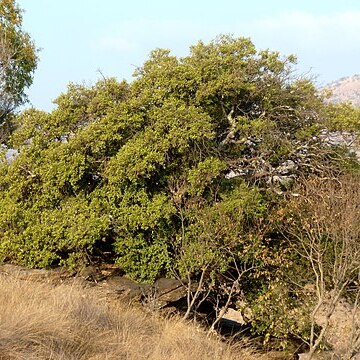Corolla white, with recurved pubescence on the lobes which may be reduced to scattered hairs or is rarely absent and with minute glandular hairs at the base of the lobes and the apex of the tube (the latter sometimes on the middle of the tube or on nearly the complete tube too), inside with curved hairs in the throat and sometimes also at the apices of the lobes and with minute glandular hairs in the tube except for its glabrous base (hairs in throat or hairs in tube are occasionally absent, although never both simultaneously); tube slightly shorter or sometimes — when calyx very short only — longer than the calyx; lobes oblong, 2–3 x as long as wide, 2–5 x 1–2 mm., obtuse or subacute at the apex.
Tree or shrub, 1-20 m high, with stringy, shredding bark. Leaves 3-nate, variously pubescent, hairs simple, branched or gland-tipped; blade elliptic-oblong to suborbicular, short or long, dense or sparse, acuminate or emarginate at apex, base cuneate, decurrent into petiole, margins entire or coarsely crenate-dentate; petioles 2-10 mm long. Inflorescences congested, terminal panicles. Corolla whitish, sometimes with mauve tint; tube cylindrical; lobes 4, reflexed, apical portion cucullate (forming a peak or umbo in bud). Ovary pubescent at apex. Flowering time Oct.-June.
Leaves ternate (occasionally 4–nate), petiolate; petiole glabrous to densely pubescent, 3–20 mm. long; lamina coriaceous or subcoriaceous, very variable in shape and size, elliptic, narrowly elliptic, obovate, nearly rhomboid, or suborbicular, 1·3–3(5) times as long as wide, (1)2–15 x (0·3)1·2–7·5 cm., acuminate to emarginate at the apex, cuneate or less often rounded at the base or decurrent into the petiole, entire or sometimes more or less distinctly serrate–dentate, or crenate, glabrous to subtomentose with stellate hairs on both sides.
Shrub or tree, 2-20 m high. Leaves petiolate, 3-nate; blade variable, from elliptic-oblong, oblong, obovate-oblong to suborbicular, 10-80 x 6-38 mm; petioles short, up to 10 mm long. Flowers: in corymbose cymes, broader than long and often overtopped by leaves; corolla white or creamy white, some flowers with purplish tint especially in bud; Feb.-Nov.
Shrub or tree, 2-20 m high. Leaves 3-nate, variable: from elliptic-oblong, oblong, obovate-oblong to subor-bicular, 10-80 x 6-38 mm, petiole short, up to 10 mm long. Cymes corymbosely arranged, broader than long and often overtopped by leaves. Flowers white or creamy white, some flowers with purplish tint especially in bud.
Calyx green, often viscid, 3–8 x 1·5–2·2 mm., minutely to manifestly pubescent with glandular and mostly also ordinary hairs outside, inside sericeous; lobes variable in size, mostly about as long as wide or wider, 0·5–2 x 1–1·5 mm., acute or less often obtuse, entire, valvate, often two coherent or partially united.
Inflorescence variable in shape and size, seemingly umbellate to paniculate, congested or rather lax, 3–15 x 3–15 cm., 3–7 times branched. Peduncle and branches hairy like the branchlets.
Pistil (4·5–)7·5–13 mm. long; ovary ovoid or ellipsoid, slightly laterally compressed, 1·5–2·5 x 1·2–2 x 1–1·5 mm., appressedly hirto–pubescent, glabrous at the base.
Leaves on sucker shoots (mostly in the shade) darker green, herbaceous, serrate, and more hairy in tropical countries, but thicker in southern Africa.
Branchlets glabrous to densely pubescent, not lenticellate, with 6(8) raised lines and often sulcate when dry.
Trunk in larger trees fluted and irregularly ridged, 5–100(200) cm. in diam.; bark pale grey–brown, fissured.
Evergreen or sometimes in Ethiopia deciduous tree or shrub, 2–25 m. high, often gnarled.
Capsule 0·5–1·5 mm. longer than the calyx, appressedly hirto–pubescent.
Tree up to 80 ft. high, sometimes with a grey fluted stem
Flowers solitary or three together, fragrant.
Stamens: anthers glabrous, 1·2–2 mm. long.
Flowers creamy-white and scented
Pedicels short or obsolete.
A tree.


